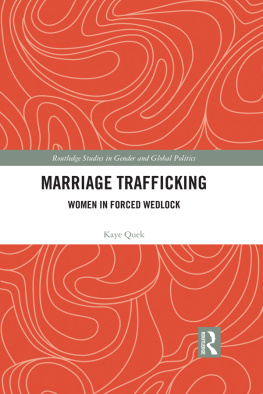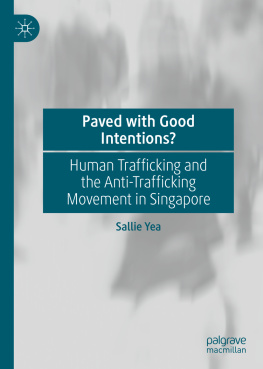Migration,
Prostitution,
and
Human
Trafficking
Migration,
Prostitution,
and
Human
Trafficking
The Voice of Chinese Women
Min Liu
First published 2011 by Transaction Publishers
Published 2017 by Routledge
2 Park Square, Milton Park, Abingdon, Oxon OX14 4RN
711 Third Avenue, New York, NY 10017, USA
Routledge is an imprint of the Taylor & Francis Group, an informa business
Copyright 2011 by Taylor & Francis.
All rights reserved. No part of this book may be reprinted or reproduced or utilised in any form or by any electronic, mechanical, or other means, now known or hereafter invented, including photocopying and recording, or in any information storage or retrieval system, without permission in writing from the publishers.
Notice:
Product or corporate names may be trademarks or registered trademarks, and are used only for identification and explanation without intent to infringe.
Library of Congress Catalog Number: 2011003367
Library of Congress Cataloging-in-Publication Data
Liu, Min, 1969-
Migration, prostitution, and human trafficking : the voice of Chinese women / Min Liu.
p. cm.
Includes bibliographical references.
ISBN 978-1-4128-1505-5
1. ChinaEconomic conditions2000 2. Migration, InternalChina. 3. Women migrant laborChina. 4. ProstitutionChina. 5. HumantraffickingChina. I. Title.
HC427.95.L584 2011
363.440951dc22
2011003367
ISBN 13: 978-1-4128-1505-5 (hbk)
Contents
China has gone through a wide-ranging transformation in the last three decades since the Chinese government initiated economic reform and an open-door policy. A series of reform strategies, while producing an economic miracle in China, has, however, resulted in myriad social problems. The resurgence and prevalence of prostitution is one of these. Rarely have there been any attempts to explore prostitution in relation to human trafficking. This study tries to explore questions such as whether Chinese women in the sex sector are victims of trafficking, what are the factors causing Chinese women to get involved in prostitution or become victims of trafficking, how authorities respond to these issues in terms of laws and policies, and so on.
This study was conducted in ShenzhenChinas best-known boom-town since the 1980s, where many sex establishments involving internal migrants have been set up. Guided by qualitative methodological approach, a total of sixty-four interviews were conducted: forty with women working in sex venues, nine with sex-ring operators, and fifteen with law enforcement officers. Eight field observations were also completed. Participants included women practicing prostitution in four types of sex venues: nightclubs and karaoke lounges; massage parlors; hair salons; and the street.
A variety of factors relating to womens involvement in prostitution were discovered. Different paths to prostitution were identified and described. Six out of forty women were identified as trafficking victims. The organization and operation of sex venues and the life of women on the job were examined. In addition, Chinas responses to the expanding sex industry were analyzed in terms of law and administrative regulations, as well as policies. The ineffectiveness of campaign-style policy and reasons for its failure to contain prostitution were also explored.
While this study helps improve our knowledge and understanding of prostitution and sex trafficking in contemporary China and provides information for the Chinese authorities on the nature, magnitude, and gravity of these problems, some issues emanating from this study remain unanswered, such as the definition of terms such as exploitation, coercion, or forced work, which are key elements in defining human trafficking.
This book is the result of two years of research and investigation, including two months of fieldwork at the research site. As with any qualitative study, it has gone through many phases: research design, IRB bureaucratic obstacles, data collection and analysis, and finalizing of the writing. Accomplishing this task would have been impossible without encouragement, support, assistance, and inspiration from many people.
First and foremost, I would like to express gratitude to Drs. James O. Finckenauer, Ko-lin Chin, and Ronald V. Clarke. Their contribution to my academic and scholarly achievement is invaluable, and is not merely limited to this study. The idea for this study was crystallized while I was a research assistant for Drs. James O. Finckenauer and Ko-lin Chin. Their guidance and advice on this research was forthcoming even before the actual commencement of the study. Similar gratitude is due to Dr. Ronald V. Clarke who was the chair of my Core Exam. His advice and guidance during the preparation of the Core Exam was immeasurable. It helped me to understand the Rational Choice Perspective, which later provided the theoretical framework of my study. Special thanks to Dr. Chin for his inspiring fieldwork, and his generosity in reaching out to me during my own.
Thanks are also owed to my friends in China who introduced me to their friends or acquaintances, some of whom became intermediaries or subjects in this study. Special thanks to those women who trusted me and shared their life stories with me. Their consent to participate in this research constitutes the most significant contribution to this studyit would be an unaccomplished mission without them.
I also would like to express my gratitude to Rutgers University School of Criminal Justice and Graduate School for their financial aid towards my fieldwork and during the writing of this book.
Last, but not least, I would like to express gratitude to my family for their ongoing support, and my daughter, Jamie, who is always a source of joy.
Prostitution, one of the oldest professions in the world, has existed in China for over 2,000 years (Ren, 1993; Gil and Anderson, 1998; Zhou, 2006), despite economic development, cultural traditions, changes in social systems, and authoritative suppression. Historically, prostitution has been a topic of research in differing disciplines, such as law, psychiatry, penology, sociology, history, geography, and social work (Davis, 1993). To date, however, few studies have examined the relationship between the increase in prostitution and the development of a society, that is to say, the extent to which economic development, industrialization, and urbanization affect the development of prostitution. In the United States, it has been observed that prostitution evolved into a highly visible business along with the economic development, industrialization and urbanization of the mid-nineteenth century (Barry, 1995). In China, although prostitution prospered under several dynastic reigns, it did not reach its peak until the country opened its door to the outside world during the second half of the nineteenth century (Zhou, 2006). Coincidently, from 1978 onward, as the Chinese government began implementing economic reform, and adopting an open door policy, and as China began experiencing rapid economic development, moving towards industrialization and urbanization, prostitution has seen a revival. It is increasing rapidly after approximately 30 years of purported abolition.
After examining changes in prostitution in Shanghai from 1849 to 1949, Henriot (1996) concluded that prostitution could only prosper in a context where the population is growing rapidly and is diversifying; where foreign trade has opened, and people from all walks of life relocate with the hope of making a better living and attaining prosperity. Even if it is accepted that the advancement of a society, especially in the form of economic development, is inevitably accompanied by thriving prostitution, the question still remains: Why has prostitution in contemporary China been developing so rapidly in the presence of Western culture and a growing economy? Does the current climate of economic reform inevitably engender prostitution? What social changes have occurred in China since 1978, and how do these changes give rise to prostitution? The present study attempts to examine prostitution in China within the context of a society in transitionan isolated, agricultural and underdeveloped country transforming into an open, industrialized, and urbanized one.







